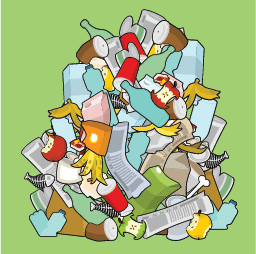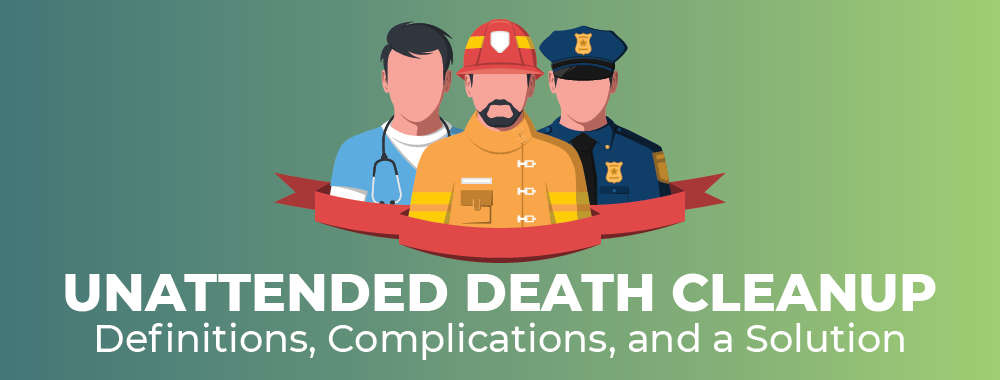You may have heard law enforcement, medical professionals, and biohazard cleaning companies use the term “unattended death“. On its most basic level, unattended death refers to the passing of any person without witnesses. Legally, the term may have more refined definitions. Here are a few:
- A patient who died while seriously ill, but not under the immediate supervision of a physician or medical staff.
- A significantly ill person who passed away more than a certain time period (days, weeks or months) since their last interaction with their physician.
- A person who passed away under suspicious circumstances.
“Unattended death” is a term usually applied to laws affecting medical examiners, who are required to fill out a death certificate for a deceased person, Each state has its own definition, and these interpretations also influence whether a police investigation or an autopsy is required.
How Bio Recovery defines “unattended death”
Companies that clean up after death use the phrase more informally because where the law is interested in the circumstances of a person’s demise, we’re focused on removing body fluids and tissue left behind once a body is removed from the premises.
All too often, when a person dies alone, they’re not discovered for a while, so “unattended death cleaning” is a professional way of referring to projects involving body decomposition. “Decomp jobs” is also an industry term, but we find it’s not one that surviving friends and family members wish to hear.
Our most common service calls
The entertainment industry refers to us as “crime scene cleanup” companies, and while we do clean everything from blood and tissue to fingerprint dust and tear gas, our job description also covers the other common causes of death. These include:
- Crime Scene Cleanup
- Suicide Cleanup
- Infectious Disease
- Hoarding Cleanup
- Unattended Death
- Vehicle Blood Cleanup
- Biohazard Removal
- Blood Cleanup
- Decomposition & Odor
- Tear Gas Cleanup
- Hazmat Cleanup
- Meth Lab Recovery
- Asbestos Abatement
- Water & Sewage Remediation
- Mold Remediation
- Fingerprint Dust Removal
Blood and body fluids can harbor dangerous pathogens for quite sometime after the human host has passed away. Improperly sanitized areas are subject to bad odors, pest infestations, and the possibility that loved ones or future occupants experience the shock of finding stains and solid matter later on.
Friends and family are rarely equipped—emotionally or technically—to confront the very unpleasant task of cleaning a home after a person has passed away, especially if trauma or the passage of time has complicated the task. That’s why biohazard remediation companies like us are so important.
Factors that affect these jobs
No two biohazard cleanup jobs are alike, and unattended death sanitization may take a few hours or several days depending upon the circumstances. Our customer support team uses nearly two decades of data from Bio Recovery’s past jobs to calculate the most accurate estimates possible.
This also helps us be better prepared for each project, so we can get in, get the job done right, and turn the property over to the responsible parties as quickly as possible.
We’ve learned that having certain information in advance helps our clients make the most informed decisions possible before they choose a biohazard cleaning service. Too many “professionals” are careless with their estimates, quoting low bids up front and subjecting their customers to “sticker shock” when the job is complete.
The following variables can turn a straightforward project into a very complicated, expensive unattended death-cleaning job:
Lapsed time, pests, and extreme saturation
The length of time that’s passed between death and its discovery is perhaps one of the most important factors in determining a project’s complexity. The longer a body decomposes, the more thoroughly biological material and gases permeate the area.
Insect pests attracted to the decomposition odors create their own health hazards, and we’ve cleaned up properties in which thousands of spiders have moved in to take advantage of the fly population. Larvae get into tight spaces, flooring, furniture, and ventilation systems, where they either perish or shed their telltale exoskeletons. Rodents, of course, leave behind feces and urine that harbor their own bacteria and viruses.
Odors permeate textiles, but they also cling to wall textures and porous structural materials. Paint doesn’t entirely eliminate bad smells, and new carpeting and padding are rarely enough. We use air scrubbing machines and non-toxic chemicals to address the source of the odors; we don’t simply cover them up.
When necessary, we remove contaminated furniture, carpeting, subflooring, and non-loadbearing structural elements that cannot be safely sanitized.
Due to the unprecedented opioid crisis, we’re responding to a large number of fentanyl-related unattended deaths. Sadly, these tend to happen after the addicted person has become physically and socially isolated from friends and family. It affects people of all ages, social status, and financial standing, in the best neighborhoods as much as the worst.
Death by gunshot and other physical violence
Gunshot wounds vary depending on caliber and the distance between the body and the muzzle when the firearm was discharged. With larger cartridges and shotgun deaths, blood, bone, brain, and tissue can travel great distances.
Often, blood turns to mist and enters ventilation systems. Solid material may fall behind furniture or lodge in surfaces. It’s not up to law enforcement, EMS personnel, or the coroner to locate and collect these materials when the body is removed from the premises, though usually, medical professionals trained in biohazard handling will do what they can.
Blunt force trauma (bludgeonings, beatings) and stabbings also result in a great deal of blood dispersal. In fact, some of the most traumatic projects we’ve attended have been homicides or assaults using bare fists. Generally, physical altercations occur in multiple areas of a property, spreading fluid-borne contaminants far beyond the actual death site.
Pre-death body condition
Pharmaceutical medications and illicit drugs can affect odors emitted by the decomposing body as well as the breakdown process. Obese bodies release higher quantities of oily fats that have their own, unique strong odors.
Decomposition fluids left by emaciated bodies, such as the elderly or those who have been sick for a great deal of time, tend to be less voluminous and therefore not as difficult to clean.
Climate and weather
Ambient temperature and humidity play a very large role in the decomposition process. Dry heat can desiccate a body, while moist air speeds up putrefaction. Cold temperatures slow down the growth of bacteria required to break down the body’s cells.
Modern, energy-efficient buildings tend to keep insect and rodent pests away from undiscovered bodies, but only if the windows and doors are kept closed. If you’d like a more in-depth look into how temperature and exposure impact our unattended death cleanup strategy, you might like to read our recent article, “How Does Environment Affect Body Decomposition?”.
Location on the property
Where the unattended death occurs is almost as important as how. Many suicides and slip-and-fall deaths happen in bathrooms and kitchens, but cracks in grout and leaks through floor vents can make a seemingly simple job a nightmare if we have to access subflooring, joists, tile backboard, and studs.
Deaths on upper floors often leak and spread throughout the structure below, requiring thorough sanitization before a restoration contractor will allow their workers to make repairs.
Concrete floors and outdoor hardscaping are surprisingly porous and prone to stains. We use absorbent material to soak up fluids and solids before washing and sanitizing hard surfaces. When death affects complicated machinery, including vehicles and industrial equipment, we clean and sanitize moving parts and detect and eliminate all traces of fluids and solids.

Hoarding
In many cases, we’re called upon to clean up a home in which debris has accumulated for quite some time. Usually, hoarding is a symptom of mental distress, but sometimes people who are socially isolated and suffering from physical illness have difficulty with household hygiene.
We’re equipped to handle the safe disposal of biohazardous waste, including spoiled food in refrigerators, human and pet feces, piled-up garbage, and hypodermic needles.
We’re equipped for any scenario
Our experienced field teams are mentally and technically prepared to address any biohazard cleaning project. They’re equipped with proprietary, non-toxic cleaning solutions and techniques, and follow a comprehensive checklist that ensures that our protocols meet or exceed guidelines set forth by OSHA, EPA, and the CDC.
Our highest standard is your expectation for a safe and sanitary property so you can be one step closer to peace of mind. If you need Bio Recovery’s industry-leading death cleaning services, contact us day or night.
We’ll do our part to make your life easier in this difficult time.


